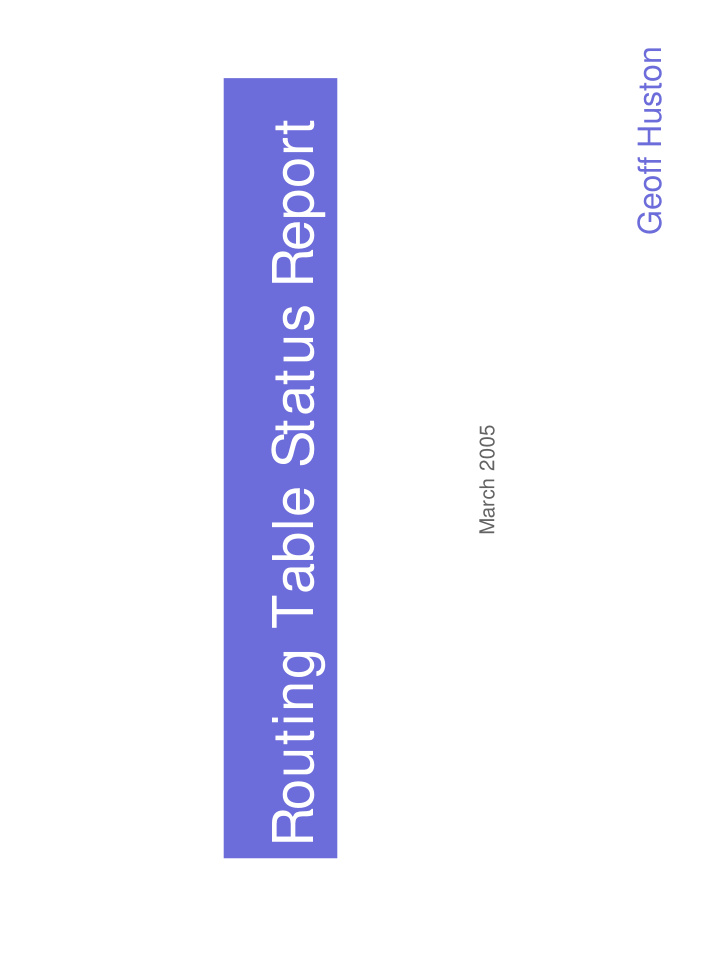



Geoff Huston Routing Table Status Report March 2005
IPv4 Routing Table Size Data assembled from Route Views data. Each colour represents a time series for a single AS. The major point here is that there is no single view of routing. Each AS view is based on local conditions, which include some local information and also local filtering policies about external views.
IPv4 Routing Table Size To provide a clearer view, a single transit view has been generated. This view shows a number of distinct phases of routing table growth: 1 – the growth of the Class C’s 88 – 94 2 – the introduction of CIDR into the routing environment in 1994 3 – the Internet boom on 1999, and its crash in 2001 4 – the post-crash growth since 2002
2003 to now Routing table growth in the last 12 months shows an increasing growth trend, although the rate of growth remains close to linear (or constant) growth rates. This figure indicates that the current table growth rate is some 18,000 entries per year. This data is based on hourly snapshots of the routing table, and the noise in the figures is based downward spikes of lost routing information and upward spikes of transient routing information, possibly due to leakage of local more specific routes. The discontinuities show points of large scale aggregation or dis-aggregation.
IPv4 Address Span This figure shows the total amount of address space spanned by the routing table. This is a view derived from the Route-Views archive, where each AS has a single colour. The snapshots are at two- hourly intervals, and span from early 2000 until the present. The strong banding in the figure is spaced 16.7M units apart, or the size of a /8 advertisement There appear to be 3 /8 advertisements that are dynamic. Not every AS sees the same address range, and this is long term systemic, rather than temporary. This is probably due to routing policy interaction, coupled with some cases of prefix length filtering of routing information. The rate of growth declined sharply across 2002 and the first half of 2003, resuming its 2000 growth levels in 2004.
IPv4 Address Span This is the same data for a single AS. It is evident thjast the number of unstable /8 advertisements has dropped from 3 to 1 over this period. It is also apparent that the rate of growth in 2004 is slightly higher than that of 2000. When comparing this to the steeply rising number of routing advertisements in 2000 it is likely that the periods of growth in the routing table correspond to periods of dis- aggregation of address blocks. This implies that the large growth periods of the routing table may be closely linked to periods of growth in policy diversity within the ISP sector, coupled with denser levels of interconnectivity.
IPv4 More Specific Advertisements
Unique ASNs Since early 2001 the number of ASNs in the routing table has been growing at a constant rate, closely matching a linear growth model. New ASNs track the growth of new service providers.
Average AS Path Length A constantly increasing number of ASNs can be related to average AS path length. The relatively constant AS path length for all AS paths implies that the density of AS interconnection is increasing at a rate proportional to the number of ASNs being added.
IPv4 Aggregation Potential This shows the aggregation potential of the entire routing table 0 – the size of the routing table in terms of number of distinct entries 1 – application of an aggregation algorithm that will only remove more specific routing entries if they match the enclosing aggregate in AS Path 2 – as with 1, but with all path prepending removed 3 – aggregation using origin AS match, disregarding AS PATH 4 – aggregation with hole coverage – i.e. aggregates across chequerboarding 5 – application of prefix length filters 6 – prepended path aggregation on filtered set 7 – prepend strpping AS path match on filtered set 8 – origin AS match on filtered set 9 – origin AS match using chequerboard coverage on filterest set
IPv6 Routing Table
IPv6 Address Span
IPv6 Unique ASNs
IPv6 Aggregation Potential
Recommend
More recommend